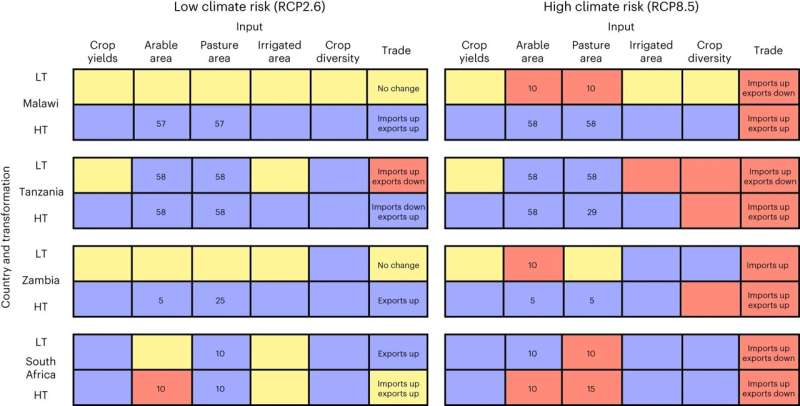This article has been reviewed according to Science X's editorial process and policies. Editors have highlighted the following attributes while ensuring the content's credibility:
fact-checked
peer-reviewed publication
trusted source
proofread
'Nutritional quality must be at the heart of climate-smart agriculture,' researchers say

According to a major research study, farmers in sub-Saharan Africa need to diversify away from growing maize and switch to crops that are resilient to climate change and supply enough key micronutrients for the population.
Maize is a staple crop across the region, where it is grown and consumed in vast quantities.
Led by Dr. Stewart Jennings from the University of Leeds, the study argues that diversification towards fruits, vegetables, and crops such as cassava, millet, and sorghum will improve nutrition security in the country, meaning sufficient micronutrients essential for good health.
The study also says the quantity of food produced must increase—and unless yields are boosted to an unprecedented level, more land will have to be brought into agricultural production.
Sub-Saharan Africa is home to around 1.2 billion people, and according to figures from the World Bank, the population will grow by an additional 740 million people by 2050.
Farmers will have to boost the amount of food grown at a time when climate change will result in increasingly extreme conditions, affecting what crops can be grown.
The researchers say the population is at risk of "food and nutrition insecurity" unless effective ways of adapting to climate change are identified. Integral to any decisions is a requirement that crops need to be nutritious and provide sufficient energy for the population.
Professor Jennie Macdiarmid, from the Rowett Institute at the University of Aberdeen and one of the authors of the paper, said, "The study has highlighted the need to place nutrition at the heart of agricultural policy to avoid the long-term unintended consequence of failing to produce food that can deliver the nutritional needs of the population.
"If policy solutions focus only on increasing production of calories and adapting to be climate smart, it is likely there will be negative consequences for health through nutritionally poor diets."
The study, "Stakeholder-driven transformative adaptation is needed for climate-smart nutrition security in sub-Saharan Africa," is published today in the journal Nature Food.
More than 50 researchers contributed to the investigation, which involved talking to policymakers and other stakeholders in the food and agriculture sectors in four countries in sub-Saharan Africa: Malawi, South Africa, Tanzania, and Zambia.
'Agriculture and nutrition policies can sit in siloes'
The researchers used the iFEED assessment framework to investigate policy options to create an agricultural system that is resilient to climate change and supply enough nutritionally adequate food to meet the food and nutritional needs of the population.
"Too often, food, agriculture, and nutrition policies sit in siloes across different government departments," said Dr. Jennings, a Research Fellow in the School of Earth and Environment at the University of Leeds.
"This study provides holistic evidence that combines information on the environmental impacts of food system changes and the changes needed for population-level nutrition security. The research shows that action can be taken to adapt to climate change and improve nutrition security in sub-Saharan Africa."
Stakeholders in each country identified key uncertainties in the future of the food system. iFEED explores these uncertain futures and identifies key policy issues that decision-makers working in the agriculture and food sectors need to consider.
The scientists say there needs to be a fundamental shift—or "transformative approach"—in agriculture to incorporate nutritional needs.
Diversifying into soybean production is one option. Soybean crops are more likely to withstand climate change's impacts than maize. Dr. Ndashe Kapulu, from the Zambia Agriculture Research Institute and contributing author to the study has been involved in studies to assess how soybean could improve the income of commercial and small-scale farmers.
He said, "Many countries in sub-Saharan Africa will better handle climate change and other stresses if they have more diverse food systems, such as the transition to soybean production in Zambia.
"As scientists, we need to generate enough evidence in our research to help make changes that support and guide actions to make the agrifood system more resilient."
Increasing the production and consumption of animal-based products in sub-Saharan Africa could also improve the nutritional quality of diets, but scientists warn that it should not reach the unsustainable production levels seen in some higher-income countries.
More animal-based products would cause a rise in greenhouse gas emissions, although the researchers say that this could be tolerable given sub-Saharan Africa's need to reduce the risk of nutritionally inadequate diets—and that its greenhouse gas emissions are relatively low.
The study involved researchers from the University of Leeds, University of Aberdeen, the Met Office, Chatham House and FANPRAN.
iFEED is a database—developed in part by the University of Leeds under the GCRF AFRICAP program and the CGIAR Initiative on Climate Resilience—to help decision makers deliver food system policies which are resilient to climate change and deliver nutritious food—reducing the risk of food and nutrition insecurity.
More information: Stewart Jennings et al, Stakeholder-driven transformative adaptation is needed for climate-smart nutrition security in sub-Saharan Africa, Nature Food (2024). DOI: 10.1038/s43016-023-00901-y
Journal information: Nature Food
Provided by University of Leeds


















